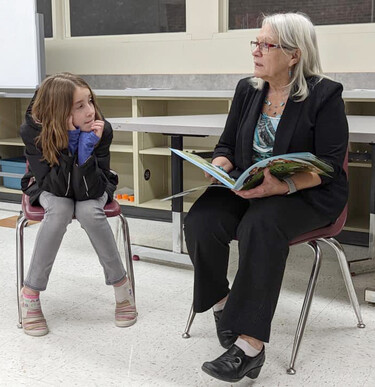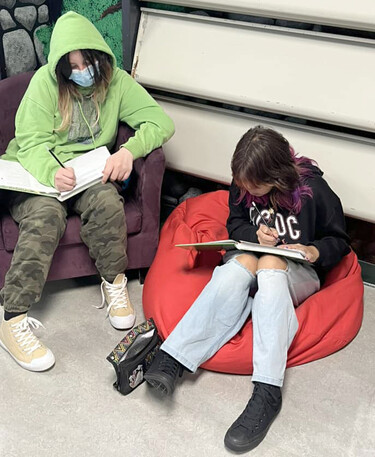
Literacy Learning in Aspen View Public Schools
Aspen View School Division promotes a Comprehensive Literacy approach. Comprehensive literacy involves the following components:

Read Aloud
Read Aloud is a strategy in which the teacher will read orally to students from texts that are above their independent reading level but at their listening level. Reading aloud exposes students to new vocabulary, builds background knowledge and provides the opportunity for the teacher to model good reading behaviours.
Shared Reading
Shared Reading is an interactive and purposeful reading experience that occurs when students participate in the reading of a book or other text as one voice while guided and supported by a teacher. This strategy gives students the opportunity to read fluently with the teacher’s voice always present.

Small Group Reading Instruction
Small Group Reading Instruction allows for students to receive explicit instruction designed to meet their needs as a learner. Ongoing assessment and observations guide instruction.
Independent Reading
Independent Reading allows students to choose reading materials and read them on their own with little to no adult support. Students should be reading books that are of interest to them and that they will enjoy. They should be self-selecting texts that they can read with at least 95%+ accuracy and also understand and make sense of. This independent time is an opportunity for students to ‘practice’ reading strategies they have learned.
Phonological Awareness
Phonological Awareness is essential in developing children’s understanding about words and sounds in words. Phonological awareness has to do with the ability to hear isolated words in a sentence, syllables in a word, and individual sounds in a word. This is essential for students to be able to begin to ‘map’ sounds to letters and begin to decode.
Word Work
Word Work involves a range of study. In the early stages, it is focussed on Phonics and then later progresses to the study of Morphemes (units of meaning within words). This work also focuses on developing fluency with high frequency words.

Writing
Writing is a fundamental skill. It is important for students to develop an early foundation in writing so they can communicate, represent and express their ideas. Instruction in writing includes the development of craft skills such as Organization, Idea Development, Language Use, Word Choice, and Voice. It must include instruction in conventions such as Printing and Keyboarding Skills, Grammar and Usage, Capitalization, Punctuation and Spelling. It also involves instruction in a variety of genres such as Functional, Narrative, Information, Persuasive, and Poetic.
(adapted from Alberta Regional Professional Development Consortia Comprehensive Literacy Guides K-6)
Aspen View uses a number of assessments to screen, diagnose and monitor the progress of students. Kindergarten teachers will use the Reading Readiness Screening Tool (RRST). Grades 1-4 teachers use the Alberta Education LeNS and CC3 assessments. Phonological awareness and phonics screeners are also used and teachers monitor reading progress with the Fountas and Pinnell benchmarking, and GB+ in French Immersion.
Numeracy
Numeracy is the ability, confidence and willingness to engage with quantitative or spatial information to make informed decisions in all aspects of daily living (Alberta Education). Numeracy is foundational to student success in education. Aspen View Public Schools promotes an approach of gradual release from concrete to visual to symbolic representations with numeracy and mathematics. This means that students engage with mathematical concepts using manipulatives such as blocks, interlocking cubes, and counters, before moving to representing their ideas with drawings and then numerical symbols. This gradual release is fundamental to teaching for understanding, rather than relying on and prioritizing rote memorization and procedure in mathematics.
An important part of instruction in numeracy and mathematics is for students to have the opportunity to communicate their thinking in a variety of ways. Communication includes verbally, with pictures and with symbols. Number talks are a common strategy that teachers will use to allow their students to talk about their mathematical understandings. Often, there are many ways to approach a problem or an idea, and students need to be able to hear from each other in order to learn and grow.
Parents play an important role in supporting their child’s developing understandings in numeracy and mathematics. Listed below are a number of games and activities that parents can use to create opportunities to notice and talk about mathematical concepts. Remember, numeracy is not just about knowing basic math facts. It has more to do with understanding numbers, being able to play with numbers, and thinking spatially.
- Play games that deal with logic, reasoning, estimation, direction, classification and time such as Memory, Chess, Checkers, word puzzles, dice games, etc.
- Talk about numbers and the different ways to “make” a number (Eg. “How many ways can you make 12?”)
- Go for a numeracy walk. Collect leaves, stones, pinecones, etc. Sort them, count them and make patterns with them. Encourage your child to explain what they notice.
- Make familiar objects available for your child to explore (e.g. toys, blocks, buttons, measuring devices).
- Provide materials such as pencils, paper, scissors, paint, chalk and glue for creative play.
- Set up a play store with objects for sale.
- Read books together and talk about the ideas related to numeracy including number, time and location.
- Cook together and include measuring ingredients. Try doubling or halving recipes. Figure out how much to make for a certain number of people.
- Plan a trip to a park, zoo or swimming pool. Talk about travel routes, time and money while planning.
- Go on a treasure hunt. Draw a map. Use directional clues such as over, under, above, below, next to and beside.
- Notice patterns in nature, such as with flowers, snowflakes, etc.
Aspen View Public Schools annually benchmarks students in Grades 1-9 in the Fall. The purpose of these assessments is to determine the needs of the students and to program accordingly. Aspen View uses a number of resources to support learning in Math. These include Pearson’s Mathology/Mathologie, JUMP Math, Mathletics and Building Fact Fluency kits.
